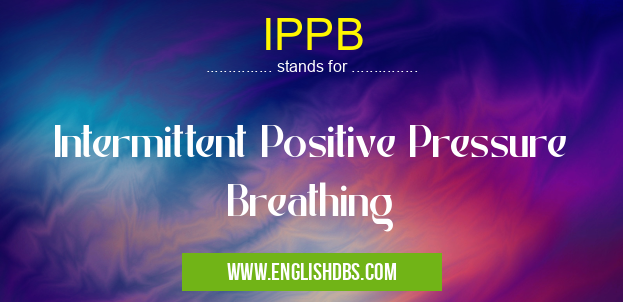What does IPPB mean in PHYSIOLOGY
Intermittent Positive Pressure Breathing (IPPB) is a type of mechanical ventilation therapy used to treat respiratory diseases. This therapy primarily helps to improve lung function and can be used in both acute and chronic conditions. IPPB also helps reduce dyspnea levels, which is shortness of breath. In this article, we will discuss what IPPB is and its benefits as well as provide some frequently asked questions about the treatment.

IPPB meaning in Physiology in Medical
IPPB mostly used in an acronym Physiology in Category Medical that means Intermittent Positive Pressure Breathing
Shorthand: IPPB,
Full Form: Intermittent Positive Pressure Breathing
For more information of "Intermittent Positive Pressure Breathing", see the section below.
» Medical » Physiology
Essential Questions and Answers on Intermittent Positive Pressure Breathing in "MEDICAL»PHYSIOLOGY"
What is IPPB?
IPPB stands for Intermittent Positive Pressure Breathing. It is a type of mechanical ventilation therapy used to treat respiratory illnesses that involve difficulty breathing. With this therapy, positive pressure is applied to the airway by using a machine connected to a mask or mouthpiece. The aim of the therapy is to improve lung function and reduce symptoms such as shortness of breath (dyspnea).
Who can benefit from IPPB treatments?
People who suffer from acute or chronic respiratory illnesses such as asthma, bronchitis, COPD, or cystic fibrosis may benefit from IPPB treatments. The positive pressure applied during the therapy can help open up airways and improve oxygenation of the lungs.
How often should treatments be done?
The frequency at which an individual needs IPBB treatment depends on their particular condition and progress over time. Generally speaking, treatments are administered 2-3 times per day for 20-30 minutes each session. These sessions may last longer if additional oxygen delivery is desired or needed.
What are possible side effects associated with IPPB?
Possible side effects associated with this type of treatment include nausea, chest pain, fatigue and headaches. Additionally, more serious complications such as pneumothorax (collapsed lung), infection or heart failure may occur if there are preexisting anatomical abnormalities in the lungs or chest wall structures.
What other therapies could be beneficial alongside IPBP?
Alongside receiving regular IPBP treatments, aerobic exercise has been shown to have a positive effect on pulmonary health for those with respiratory disorders. Exercise improves overall circulation and oxygenation as well as strengthens muscles necessary for proper breathing mechanics. Other therapies that may be beneficial include speech language pathology services for vocal hygiene exercises and pursed lip breathing techniques.
Final Words:
Intermittent Positive Pressure Breathing (IPPB) aids in improving lung function while reducing dyspnea levels in people with chronic respiratory illnesses like asthma and COPD. While undergoing this mechanical ventilation therapy, it's important to be aware of any potential side effects that may occur and seek medical attention right away if they do appear. Additionally, combining this form of treatment along with other therapies like aerobic exercise can produce even better outcomes in terms of improving pulmonary health over time.
